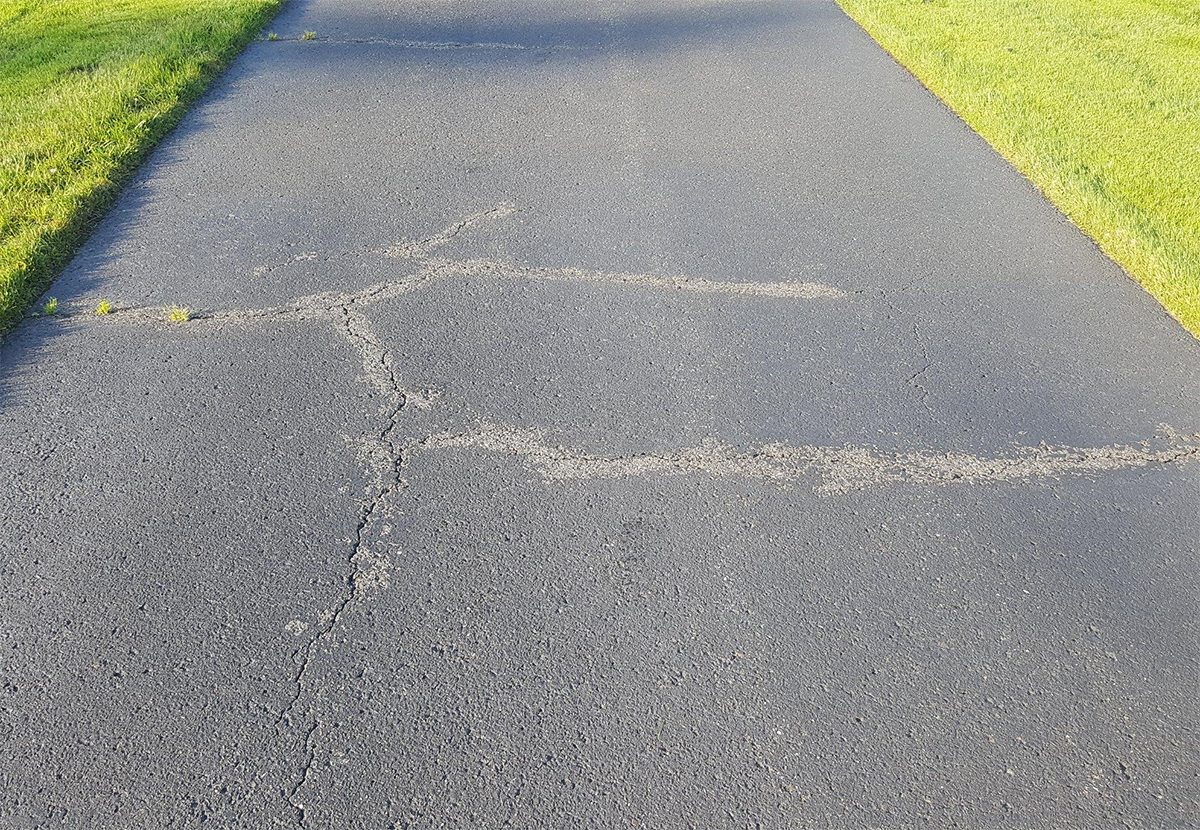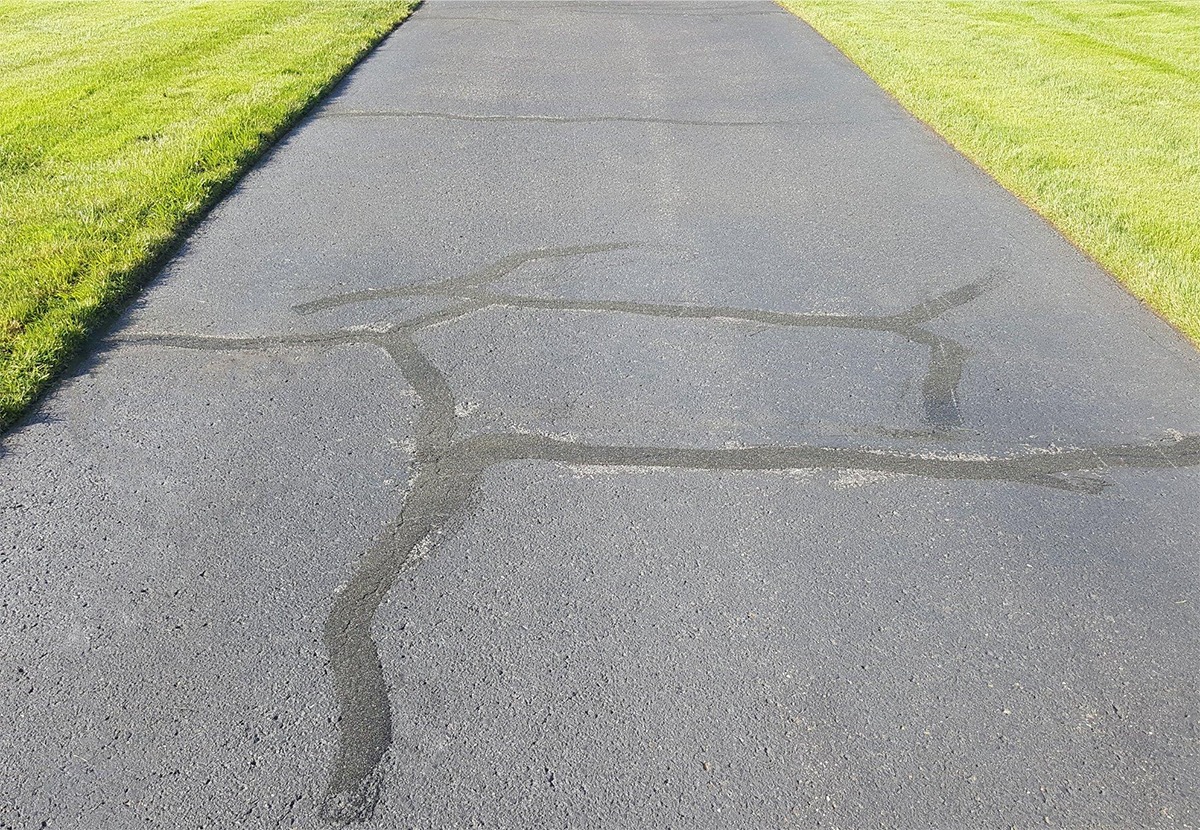HOT RUBBERIZED CRACKFILIING
Seamless Asphalt Crackfilling for Your Home, Business, or Commercial Property


The Importance of Asphalt Crackfilling
Pavement cracking is a natural occurrence over time, and no asphalt surface can be constructed to remain crack-free indefinitely. Treating cracks promptly is essential, as they create openings for moisture to penetrate the underlying layers of pavement. This infiltration leads to serious damage during the freeze/thaw cycle, where trapped water freezes in colder months and expands in warmer months. The resulting movement weakens the asphalt, causing cracks to widen and contributing to significant deterioration.
The Consequences of Untreated Cracks
The shrinking and expansion caused by seasonal changes destabilize the foundation and other layers of asphalt. This process can result in:
- Potholes
- Base failures
- Accelerated overall pavement deterioration
Neglecting cracks leads to costly repairs, reduced pavement lifespan, and diminished serviceability for your property.
The Solution: Routine Crackfilling Maintenance
A proactive approach to crackfilling through regular inspections and maintenance is critical to preserving the structural integrity and longevity of your asphalt. By sealing cracks early, you prevent water intrusion and avoid larger, more expensive repairs down the line—ensuring the long-term financial health of your property.
What Is Crack Sealing and Why Is It Important?
Crack sealing is a preventative asphalt maintenance technique that involves filling and sealing pavement cracks with a polymer-based, rubberized material heated to 350°F. This affordable preservation method is one of the most cost-effective solutions for extending the life of asphalt surfaces and maximizing maintenance budgets.
Why Choose Crack Sealing?
- Prevents Deterioration: Seals out moisture, protecting the pavement’s foundation.
- Extends Lifespan: Adds an additional 3–5 years to the life of your paved surfaces.
- Budget-Friendly: A low-cost solution compared to extensive repairs or resurfacing.
By addressing cracks early, crack sealing reduces the risk of larger issues like potholes and structural failures, making it an essential step in maintaining your asphalt’s longevity and performance.
Warning Signs Your Asphalt Pavement Needs Crack Sealing
When fractures appear in your asphalt, timing is everything. Addressing cracks promptly prevents further damage and saves you money in the long run. The sooner you seal those cracks, the less costly the repairs will be, as delaying maintenance can lead to more extensive and expensive issues.
Smart property owners and managers know the value of regular inspections, keeping an eye out for cracks and other damage in their parking lots. If you notice any of the following types of cracks in your pavement, it’s time to schedule a professional crack sealing consultation.
Understanding the Different Types of Asphalt Cracks
When you notice cracks in your pavement, acting quickly is essential. Delaying repairs allows the damage to worsen, leading to more extensive—and costly—issues down the line. The sooner you address pavement cracks, the more money you’ll save by preventing further deterioration.
Savvy property owners and managers understand the importance of regular inspections and promptly addressing cracks or other damage in their parking lots. If your pavement shows signs of cracking, it’s time to schedule a professional crack sealing consultation to protect your investment and extend the life of your asphalt.
Reflective Cracking
This type of crack typically appears during resurfacing projects but can also develop in brand-new pavement. It occurs when an existing joint or crack in the underlying pavement structure reflects upward through the top layer of asphalt.
Fatigue or Alligator Cracks
Over time, flexible asphalt pavement loses its ability to absorb vertical deflections and becomes more rigid. This increased rigidity leads to tension in the pavement, resulting in the formation of alligator cracks—a pattern resembling the scales of an alligator. These cracks can also form due to oxidation, aging, or structural deficiencies in the pavement.
When addressing alligator cracking, it’s generally recommended to replace the affected areas entirely rather than attempting to fill or seal them, as this ensures a more durable and long-lasting solution.
Longitudinal & Joint Cracks
Pavement “joints” are created during initial construction when the edges of two asphalt mats are placed next to each other. These joints often have a lower asphalt density compared to the surrounding pavement. Joint cracks can develop if the mats fail to bond properly, which can occur for various reasons.
Block Cracking
This type of cracking typically forms a square pattern, with fractures intersecting at nearly right angles. Lack of traffic is a common cause in parking lots, as consistent traffic helps “knead” the pavement, keeping it flexible. Other contributing factors include excessively high plant mix temperatures, large air voids, and low-penetration asphalt.
Slippage Cracks
Slippage cracks are typically crescent-shaped and occur in areas with heavy traffic, especially where vehicles frequently brake, turn, or accelerate. These cracks result from a bond failure between the upper and lower pavement layers, caused by the stresses generated during these movements. The open end of the U-shaped crack always points in the direction of the applied force.
Slippage cracks are often caused by contaminants, such as dust or debris, between the layers of asphalt during construction.
Edge Cracking
Edge cracks are unique in that they form parallel to the pavement edge, typically within 18 inches of it. These cracks are often caused by a weak base, insufficient shoulder support, poor drainage, or frost action.

Services
Driveway Sealcoating
Garage Floor Coating
Asphalt Maintenance
Commercial Flooring
Corporate Office
11262 Kilmer Rd
Edison, NJ 08872
Phone
NJ (732-524-7757
VA (804) 234-3180